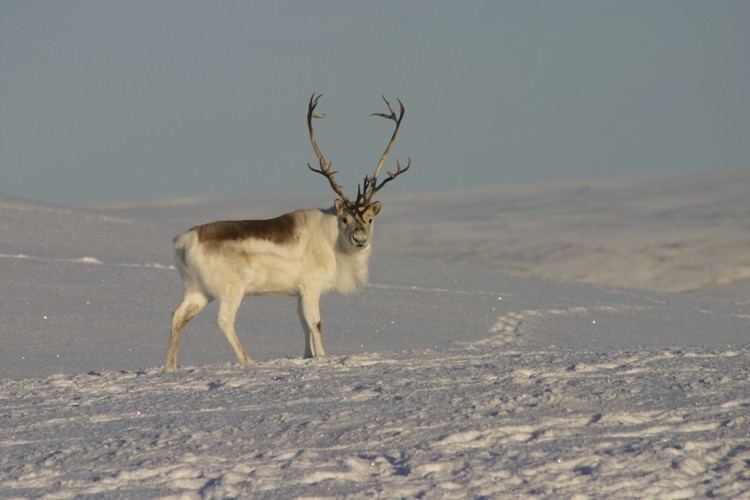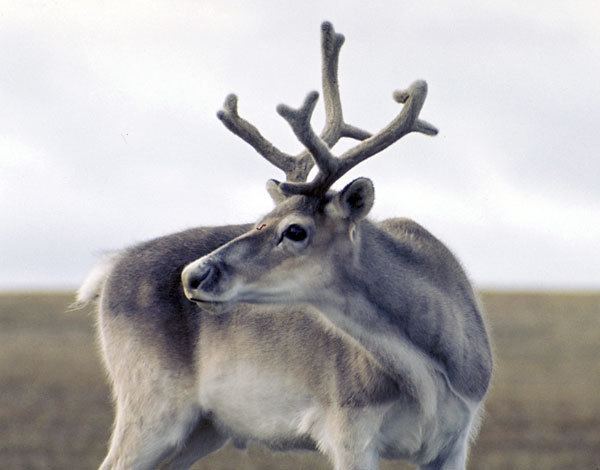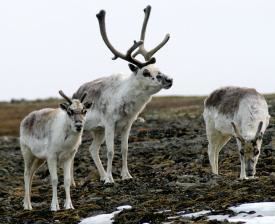Order Artiodactyla Scientific name Rangifer tarandus pearyi Rank Subspecies | Phylum Chordata Family Cervidae Genus Rangifer Higher classification Reindeer | |
 | ||
Similar Barren‑ground caribou, Deer, Mammal, Boreal woodland caribou, Svalbard reindeer | ||
The Peary caribou (Rangifer tarandus pearyi) is a caribou subspecies found in the high Arctic islands of Canada's Nunavut and Northwest territories. They are the smallest of the North American caribou, with the females weighing an average of 60 kilograms (130 lb) and the males 110 kilograms (240 lb). In length the females average 1.4 m (4.6 ft) and the males 1.7 m (5.6 ft).
Contents

Like other reindeer, both the males and females have antlers. The males grow their antlers from March to August and the females from June to September, and in both cases the velvet is gone by October. The coat of the caribou is white and thick in the winter. In the summer it becomes short and darker, almost slate-grey in colour. The coat is made up of hollow hair which helps to trap warmer air and insulate the caribou.

The males become sexually mature after two years and the females after three years. Breeding is in the fall and depends on the female having built up sufficient fat reserves. The gestation period last for 7 to 8 months and one calf is produced.

Peary caribou feed on most of the available grasses, Cyperaceae (sedges), lichen and mushrooms. In particular they seem to enjoy the purple saxifrage and in summer their muzzles become purple from the plants. Their hooves are sharp and shaped like a shovel to enable them to dig through the snow in search of food.

The caribou rarely travel more than 150 km (93 mi) from their winter feeding grounds to the summer ones. They are able to outrun the Arctic wolf, their main predator, and are good swimmers. They usually travel in small groups of no more than twelve in the summer and four in the winter.
The Peary caribou population has dropped from above 40,000 in 1961 to about 700 in 2009. During this period, the number of days with above freezing temperatures has increased significantly, resulting in ice layers in the snow pack. These ice layers hinder foraging and are the likely cause for dramatic drops in caribou population in the future.
The Peary caribou, called tuktu in Inuinnaqtun/Inuktitut, and written as ᕐᑯᑦᓯᑦᑐᒥ ᑐᒃᑐ in Inuktitut syllabics, is a major food source for the Inuit and was named after Robert Peary.
Ebm 2014 peary caribou
Pelage
During the winter, the fur of the Peary caribou becomes thicker and whiter. In the summer it is shorter and darker. The pelage of the Peary caribou is white in winter and slate-grey with white legs and under-parts in summer like the barren-ground caribou the Dolphin-Union Caribou population. The Dolphin and Union caribou are slightly darker.
Like all caribou the hollow hairs help trap warm air and insulate their bodies.
Antlers
The Peary caribou and Dolphin-Union Caribou have light slate-grey antler velvet. The antler velvet of the barren-ground caribou and woodland caribou are dark chocolate brown.
Habitat
The Peary caribou migrate seasonally up to 150 kilometres (93 mi) each way. They occupy high arctic islands, including Banks Island, Prince of Wales Island (Nunavut), Somerset Island (Nunavut) and the Queen Elizabeth Islands. In summer they search for the richest vegetation which is found "on the upper slopes of river valleys and uplands." In the winter, they "inhabit areas where the snow is not too deep such as rugged uplands, beach ridges and rocky outcrops."
Aulavik National Park in the Arctic lowlands at the northern end of Banks Island is home to the Peary caribou. The Thomsen River runs through the park, and is the northernmost navigable river (by canoe) in North America. Aulavik National Park of Canada, a fly-in park, protects about 12,274 km2 (4,739 sq mi) of Arctic lowlands at the northern end of the island. In Inuvialuktun Aulavik means "place where people travel" and caribou have been hunted there for more than 3,400 years, from Pre-Dorset cultures to contemporary Inuvialuit.
The last live caribou reported from Northern Greenland were most likely Peary caribou that had strayed from Ellesmere Island. They were seen in Hall Land in 1922.
Conservation
It was assigned a status of threatened in April 1979. In May 2004 the Committee on the Status of Endangered Wildlife in Canada (COSEWIC) listed the Peary caribou as endangered.
"The original designation considered a single unit that included Peary caribou, Rangifer tarandus pearyi, and what is now known as the Dolphin and Union population of the barren-ground caribou, Rangifer tarandus groenlandicus. Split to allow designation of three separate populations in 1991: Banks Island (Endangered), High Arctic (Endangered) and Low Arctic (Threatened) populations. In May 2004 all three population designations were de-activated, and the Peary Caribou, Rangifer tarandus pearyi, was assessed separately from the Barren-ground Caribou (Dolphin and Union population), Rangifer tarandus groenlandicus. The subspecies pearyi is composed of a portion of the former "Low Arctic population" and all of the former "High Arctic" and "Banks Island" populations."
